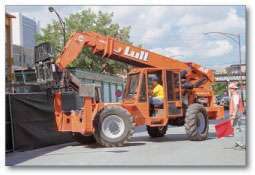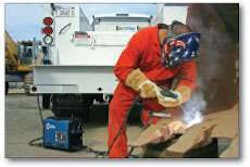Low hours, long lifecycles and a versatile range of applications make for a machine that delivers value for multiple tiers of users for many years.
By Tom Jackson
As with most construction machines, the purchase price of a telehandler pushes into the six figure category. But unlike earthmoving machines that depreciate as their teeth, tracks and components wear out, telehandlers hold their value and give you years of service with very little additional upkeep and investment. And in these times when equipment dollars are hard to come by, a telehandler with the right attachments can perform a number of different applications.
To find out more about the owning and operating costs of telehandlers we turned to Jeff Ford, senior manager of marketing communications and Brian Boeckman, product manager for the telescopic material handler line at Skytrack, Lull and JLG. Ford and Boeckman suggested we study the JLG Model G10-55A. It has a 10,000-pound lift capacity with 55 feet of lift height, 42 feet of vertical reach and a 125-horsepower diesel engine. The G10-55A sits near the large end of the telehandler market. Smaller telehandlers, typically around 6,000 pounds of capacity, are used for residential applications. But with the homebuilding market down, the 10,000-pound machines are the most popular right now and finding work in the commercial building and masonry construction, petrochemical and refinery applications and plant and factory building.
Determining lifecycle

An industrial application where the machine is being used 24/7 can be quite hard on telehandler, Boeckman says. A more normal or average application would be in construction where it’s working 10 to 12 hours a day. “A masonry application is fairly typical where you use the machine to feed the bricklayers and block layers and the machine is running the whole time those guys are working, going back from the scaffolding to get the block or the mortar and bringing it back up and continuing to make those passes.” A less severe application would be something like a framing job, where the machine places trusses, sheathing or drywall on the upper floors of a building intermittently and then is idled.
Different owners
Because of their long useful lifecycles, most telehandlers are likely to have more than one owner, says Boeckman. “The first user might be a large rental company or a large contractor,” he says. “They may keep machines five to seven years before they refresh their fleet. The second tier user may be a smaller contractor or a small rental company. They may hold onto that machine for another 10 years, because it is not used extensively in their application. The third tier is more likely an agricultural user, or very small contractor and they’ll pick them up through the auctions.”
The number of hours a telehandler will put in during a year is all over the map. Rental units may see 700 to 1,000 hours per year. Residential and light commercial construction applications probably range from 500 to 700 hours. Boeckman says he’s seen some contractors put as much as 3,000 hours a year on a machine, but a mid-range figure would probably be 1,000 hours.
Trade in value
Resale values for telehandlers in this size class will vary considerably. “In the secondary market it depends on the age of the machine and the hours and to some degree the spec of the machine,” Boeckman says. “It also depends on how the market is doing at the time.” If the market is strong and manufacturers are having a hard time meeting demand, used equipment prices will be higher. The opposite happens during a recession like the one we’re in now. When there’s a lot of unsold inventory, used equipment prices tend to fall.”
To get a closer estimation of resale values, we took a look at what Top Bid’s online auction pricing guide (www.topbid.com) had for the JLG G10-55A. There were 17 of these machines in the database, at auctions from June 2005 to present. The low price was $28,000, high price $52,000 and an average of $39,137. The machines ranged in age from three to seven years and hours ranged from 700 to 2,700 with an average of 1,633. It’s probably safe to assume that a lot of these were rental units, which would be auctioned earlier, and have fewer hours than a contractor machine. Obviously there are many variables here but for an approximate number for our owning and operating costs we’ll guesstimate that a five-year-old, 5,000-hour machine would bring $30,000.
Maintenance
The key to extracting the most value for your equipment dollar is to keep up with the maintenance. This is especially true with a machine like a telehandler. With their intermittent use, low hours and long lifecycles it might be easy to overlook scheduled maintenance, but neglect here will certainly come back to bite you in the pocketbook later.
Since an engine and hydraulic rebuilds would probably be the most expensive maintenance item, we suggest you do regularly scheduled oil analysis and follow contamination control procedures. In harsh applications an engine rebuild might be warranted after 5,000 hours, says Boeckman. More normal applications would stretch that to 7,000 or 10,000 hours. But in any case, oil analysis and strict adherence to a PM schedule will lengthen engine and component life.
While not specific to any particular brand, we found services on the Internet that will perform 250-hour telehandler services for $525 (air and oil filters, lube change, grease and zerk fittings as needed) and 500-hour services for $825 (air, oil, transmission, fuel and hydraulic filters; grease/zerk fittings; differential fluid, engine lube and wet brake oil in hubs.) These prices include parts and labor, by a third party provider. You can save on labor if you do the work yourself. If you’re buying a new machine from a dealer you might also save some money by getting a package service agreement. On our 5,000-hour study machine this adds up to $6,750, or $1.35 per hour.
Additional costs:
Fuel. Expect to burn about 3 gallons of diesel per hour of engine time on this size of telehandler, Boeckman says. Heavy lifting and high-speed/long distance travel will bring this figure down. Good operating procedure and limited idling will improve fuel efficiency. Diesel is currently selling at about $3 a gallon but keep in mind this can change.
Tires. As with fuel use, training your operators on being careful with the tires will pay off in the long run. On hard surfaces telehandler tires will eventually wear out. But when they’re used on unimproved construction jobsites hazards such as rock, rebar and other debris can damage a tire before the tread is fully worn. Some of this is unavoidable, but careful operators can reduce your risks. Expect to pay $450 per tire or $1,800 a set and replace them at an estimated 2,000 hours. Note in especially harsh applications some contractors use foam filled or solid tires to reduce the risk of flats and these cost considerably more than pneumatic tires.
Wages. For safety reasons a telehandler operator should not be a low-skill employee or somebody who is new to equipment. The Occupational Safety and Health Administration requires telehandler operators to be trained and certified in most applications, so this is no place for a minimum wage newbie. We ballparked the wage figure at $20 per hour and $30 total when you include benefits. EW










